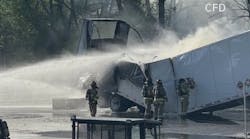To make this classification process more valid for the survey team, we urge you to begin thinking of any target hazard risk within your community as falling into one of three different areas:
- Life safety.
- Property conservation.
- Community consequences.
How many people might be at risk in a large high-rise apartment structure? Unless the complex is inspected, no one will know until it is too late. What devastation might come from an uncontrolled lumberyard fire in a business district? The ability to answer these types of questions might mean the difference between needing three pumpers or five pumpers to protect a community. Your responsibility to the people you are charged with protecting demands that you be able to justify fire protection in a reality-based manner.
What if a large employer lost its facility in a major fire? What effect could this have on the economic health of a city? These are only a few of the crucial problems which could be addressed by a municipal risk survey.
When might a fire occur? Rather than depending upon some arbitrary external standard, review the fire experience over the last decade. Are fires happening in the evening, at night or during daytime periods? This type of analysis can affect staffing changes which might be needed to cover peak work periods. It can also assist in the planning phase for volunteer fire departments, as well as small combination and career fire departments. These fire departments, over others, periodically experience personnel shortages during the normal 8 A.M.-4 P.M. workday.
A pattern of fire occurrence is part of the basis for any future planning. It may be that a community might need to contract with a surrounding jurisdiction for daytime fire protection services. Fire department records also hold the key to discovering how and why fires happen. By reviewing past fire investigation reports, patterns of fire occurrence can be studied and trends for the future identified. The records of various national organizations can also be of assistance in targeting areas of your community for improved fire protection services.
Might it help to know that 29 percent of all ignition scenarios reported in manufacturing properties for the period 1974-1983 involved fixed wiring? It would if your community has a number of manufacturing plants. And would it be disturbing to learn that 92 percent of structure fire deaths still occur in the home? It should provoke the thinking fire administrator, regardless of locale. It can also help to target operational and fire prevention resources. A significant emphasis must be placed on the need for an effective record keeping system. Should one not presently exist, it is vital to develop one now. Records are the basis for properly understanding how vulnerable a community is to fire.
Obviously fire risk is a complex and multi-faceted concept, but it is one which must be mastered if a fire department is to determine to optimum level of protection for the community. Without records, the administrator is forced to guess at the level of risk in his community. However, rather than guess at levels of risk, the answer to what is needed in a community can best be answered by a full-scale, community field survey.
What resources does a community need to measure fire risk? In order to answer this critical question, some form of measurement is necessary so that valid and equal comparisons of risk to protection can be made. Inherent in the measurement of risk is the implication that it can be moderated by outside intervention. Any comparisons made involving measuring fire department resource requirements must be realistic. Your study should involve comparisons against the risk requirements posed by target hazards in the community. Three areas have been identified by the National Fire Academy as being valid measurements of the level of community fire risk:
- Required fire flow.
- Life risk (firefighters/civilians).
- Community consequences of a fire.
A true picture of a community's fire protection needs will come only after a meticulous study of each of these areas of risk. By developing a series of required fire flows for the target hazards in a community, that community can compare the needs of the hazards with the fire department's ability to meet those needs. It is also important to look at the level of personal risk to which people in the community are exposed in a given situation. A greater risk may require a greater commitment of resources, or the implementation of new fire prevention, code enforcement or public education programs.
Knowing the devastating effect that a fire may have upon a community can be crucial. It will assist the fire department in selling the need for additional municipal fire protection. And selling is what you will be forced to do in many cases. People want you to protect them, but they do not want to pay for it. Historical reference can be made to numerous instances where a community has been destroyed by the effects of a major fire. A good example could be the Chicago Fire. A more recent example might be the Oakland firestorm. No community can risk a disaster.
In our next column, we will look at the various factors you must come to know.
Harry R. Carter, Ph. D., a Firehouse® contributing editor, is a battalion chief with the Newark, NJ, Fire Department and past chief of the Adelphia, NJ, Fire Company.




